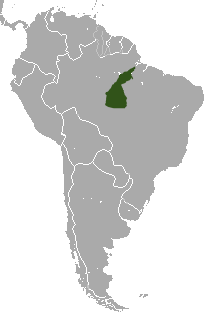Spix howler monkey
| Spix howler monkey | ||||||||||||
|---|---|---|---|---|---|---|---|---|---|---|---|---|

Spix howler monkey ( Alouatta discolor ) |
||||||||||||
| Systematics | ||||||||||||
|
||||||||||||
| Scientific name | ||||||||||||
| Alouatta discolor | ||||||||||||
| ( Spix , 1823) |
The Spix howler monkey ( Alouatta discolor ) is a species of primate from the family of the spotted monkeys (Atelidae). It occurs in the southeastern Amazon basin between the rivers Rio Tapajós and Rio Juruena in the west and Rio Iriri and the lower reaches of the Rio Xingu in the east.
features
Male Spix howler monkeys reach head-torso lengths of 57 to 91.5 cm, have a 65 to 67 cm long prehensile tail and weigh 6.5 to 8 kg. In the females, the head-trunk length is between 46.5 and 57 cm, the tail length between 60.5 and 65 cm and the weight between 4.8 and 6.2 kg. The basic color of the monkeys varies from dark brown to black. The back, hands and feet and the tip of the tail are red-brown to chestnut-colored.
Way of life
Spix howler monkeys occur in rainforests that are not periodically flooded (Terra Firme forests), evergreen tropical floodplain forests ( Igapó forest ), in marshland with palm trees ( Euterpe ) and in secondary forests. They live in small groups of up to nine animals made up of one or more males and several females with their young, or in pairs. Like all howler monkeys, their diet is almost exclusively vegetable. Fruits make up the majority of the food consumed, and leaves, flowers and bark are also eaten. Twigs, pseudobulbs from orchids and substrate from the nests of tree-dwelling termites are taken up to a very small extent. Compared to the diet of most other howler monkeys, which mainly eat leaves, the Spix howler monkey's diet consists mainly of fruits. Legumes and the fruits of the mulberry family , especially figs , are particularly important.
Systematics
The Spix howler monkey was described in 1823 by the German scientist Johann Baptist von Spix under the scientific name Mycetes discolor . For a long time it was considered a subspecies of the red-handed howler monkey ( Alouatta belzebul ), but was raised to the species rank in 2006 because of the different morphology of the skull and hyoid bone and the different coat color.
Danger
The IUCN estimates the existence of the species as endangered (Vulnerable). The main threats to the species are deforestation and hunting. Today the habitat is cut through by the east-west running Transamazônica and the north-south running Brazilian federal highway BR 163 ( Cuiabá - Santarém ).
literature
- AB Rylands & RA Mittermeier: Family Atelidae (Howlers, Spider and Woolly Monkeys and Muriquis). Pages 528 in Russell A. Mittermeier , Anthony B. Rylands & Don E. Wilson : Handbook of the Mammals of the World - Volume 3: Primates. Lynx Editions, 2013 ISBN 978-8496553897
- Liliana Cortés-Ortiz, Anthony B. Rylands, Russell A. Mittermeier: The Taxonomy of Howler Monkeys: Integrating Old and New Knowledge from Morphological and Genetic Studies. Developments in Primatology: Progress and Prospects 2015, pages 55–84, Springer, New York, DOI: 10.1007 / 978-1-4939-1957-4_3 , ISBN 978-1-4939-1956-7
Web links
- Alouatta discolor in the Red List of Threatened Species of the IUCN 2008. Posted by: Boubli, J.-P., Di Fiore, A., Rylands, AB & Mitter Meier, RA, 2008. Accessed June 18, 2015.
